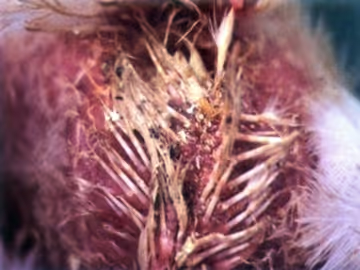
Infectious Bursal Disease(GUMBORO), IBD, or Gumboro Disease is a viral disease affecting young chickens, worldwide. The IBDV virus attacks the bursa of fabricius, an internal organ found inside the cloaco opening used for intestinal, reproductive and urinary functions in chickens. The bursa of fabricius contains lymphoid cells and is primarily an internal tissue for absorption and protection, critical to the development of healthy blood components and immune systems.
This virus is transferred between chicks through infected feces that are ingested by other chicks. Chicks may present with symptoms including: watery and bloody diarrhea, and a swollen and blood-stained vent, as early as 2 weeks of age. Because this virus attacks the immune development, some infected chicks will die within 3 to 6 weeks of age; mortality rates can be 40% or higher. Infected birds can continue to excrete this virus for two weeks after infection. Chicks, 8 weeks of age or older, have developed immune systems, and are more resistant to infection.
Vaccination during an outbreak is not effective, and no known treatment is available. Disinfecting liter, housing and water supply is critical to prevent further spread as many different strains have developed over time.

Infectious Bursal Disease(GUMBORO) Cause:
Virus (Infectious bursal disease virus)
Infectious Bursal Disease(GUMBORO) Signs:
– More susceptible to chickens between 3-6 weeks.
– Drop in feed and water consumption.
– Whitish watery droppings leading to soiling of feathers around the vent, and vent picking.
– Feathers appear ruffled.
– Chicks are listless and sit in a hunched position.
– Death of chickens within 3 days from when they first develop signs of illness.
Infectious Bursal Disease(GUMBORO) Transmission:
– Bird-to-bird contact between infected birds and uninfected birds; breathing contaminatedair; and contact with contaminated people and equipment.
Treatment:`
– There is no treatment. Antibiotics (oxytetracyclin) prevent secondary bacterial infections.
Prevention:
– Vaccination of all birds with Bursine II vaccine on day 7 and repeat on day 21. Followwell designed vaccination schedule.
Dont forget to share
Recovery:
The virus is very stable in the environment so, it is usually not possible to prevent the spread of cases from previous flocks to new flocks. Vaccination is the key to recovery.
